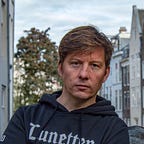Changing the future of food, one prototype at the time
How Data fuels the Transformation of our Food System
Last week I attended FarmHack’s Short Supply Chain Hackathon. Like always there were many interesting challenges, with lots of data prepared by the organization. I decided to join Daam Rutten (a Jheronimus Academy of Data Science graduate) for the Herenboerderij challenge that focuses on a demand driven cultivation plan.
TL;DR: we won the 2019 short supply chain FarmHack 🏆.
From the original challenge: The “Herenboerderij” is a small farming cooperative, owned by approximately 200 families (“Herenboeren”). Together they decide what to eat and what the farm shall produce. The farmer, who is employed by the cooperative, grows a dozen types of fruits and vegetables and looks after the farm animals that produces meat and eggs. Their challenge is about making their cultivation plan demand driven.
For the farmer, the entire growing season the rotation plan is a huge puzzle. Too often there is a mismatch between supply and demand. Their plan is 1 in 8, while offering their members 5 types of vegetables every week. Currently they develop their cultivation plan by looking at the physical conditions of an area. They have a spreadsheet, with 60 types of crops. A demand driven cultivation plan is a challenge now, but could be a unique selling point for all short-chain farmers!
Our future food system: back to nature
Focusing on growth only in the food industry has had catastrophic consequences. We have exhausted our land with our monoculture practices, producing or growing a single crop, plant, or livestock species, variety, or breed in a field at a time.
“Technology is our friend in the transformation of our food system.”
The consensus in the agriculture and food industry is that this has to stop. We have to strive to change the system in a way that nature is in balance again. We need to get back to an ecosystem where biodiversity rules, lands flourish and also deliver enough food. Technology is our friend in this transformation.
This is how the current transformation looks like:
So in short this is how we manage our food system:
- No cultivation: nature was just nature.
- Monocultivation: producing a single crop
- Strip cropping: crop rotation in strips
- Pixel farming: optimal crop rotation & companion planting per pixel using data & robots to produce
- Permacultivation: simulating or directly utilizing the patterns and resilient features observed in natural ecosystems
If this is news for you, no worries, before the hackathon I was also a complete n00b about this. Another reason these hackathons, or focused proof of concept sessions, are great deep dives into any complex problem.
And nice all this inspiration, but “Did you manage to deliver? Did we, in fact, ship?” you might ask yourself?
Nature driven, data obsessed
Back to the challenge: with farming becoming more and more complex farmers are faced with an enormous puzzle. How to grow your crops optimally, listening to what the customers wants to eat, while growing enough crop and in an environmental friendly way?
This requires a lot of data to optimize. But luckily we came up with Croptimizer (Ba dum tss! 🥁) an user friendly, dynamic cultivation plan. With our Next Best Crop™ technology we connect all meaningful data about soil, harvest, weather and whatever sensors you have installed and give a recommendation on what crop to plant next.
”Farming will stay a very interesting and future proof carreer”
Let our algorithms crunch the data; matching customer demand, optimal harvest parameters and what works best for nature. Farmers can still tweak and run experiments, working together with our software. Yes, this changes the craft of farming, significantly. But in our opinion farming will stay a very interesting and future proof carreer.
Why data science enables the killer business model
Whenever we use computer models to optimize some sort of situation it is good to understand real data, data from the real situation, can be used to improve the computer models.
In this case, Herenboeren is growing fast and growing wide, farms are being opened in the Netherlands and elsewhere. Together they are a community of data driven farmers, delivering data to improve the algorithm we deploy.
“Train an algorithm that determines optimal cultivation”
This is what we mean that data is worth gold. If you have the right data, the data that helps train an algorithm that determines optimal cultivation. I would argue that the algorithm is the most valuable, having access to knowlegde of the best way to cultivate your land is one of the key questions of our times.
Exciting times for everyone that is working on the interface of agriculture, food and data. Are you interested to work on a proof of concept yourself? Join my proof of concept lab.
